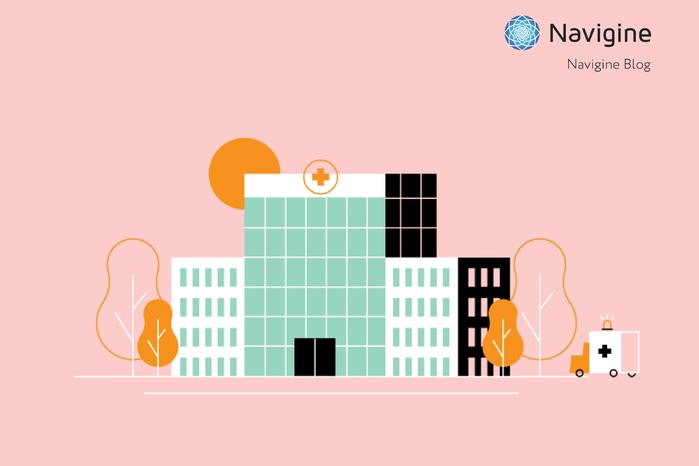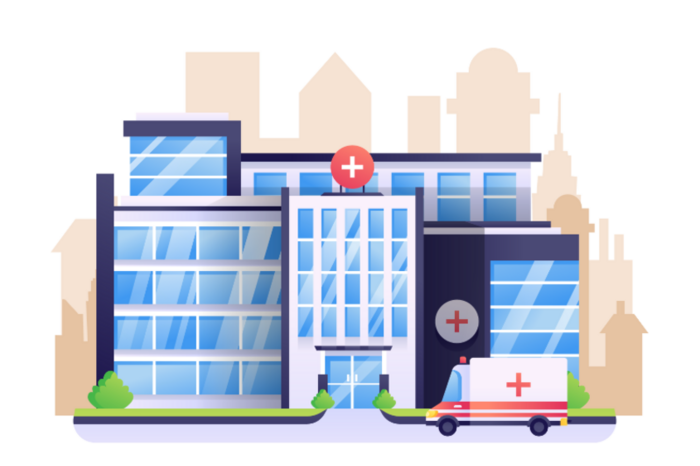Img Source - Lina Leusenko
Visiting a clinic or hospital brings a lot of stress to patients. Most medical institutions include many buildings, hallways, and floors, which force people to wander around the territory for a long time in search of the right office. This is not very convenient, especially whenever an individual isn’t feeling well. Clinics have to constantly deal with complaints, such as frustration with the stay time, the need to look for the right office, and the issues with finding emergency exits.
Medical professionals face just as many navigational issues. In search of equipment or free rooms, employees lose a lot of precious time that they could dedicate to the patients. To solve such problems, it’s beneficial to implement RTLS (Real-time Locating Systems). Introducing indoor navigation and patient location tracking improves the quality of service, makes customers more loyal to the clinic, and can even increase the overall profit of the medical institution.
What Is an Indoor Navigation & Positioning System?
Indoor navigation and positioning systems for hospitals are a set of software and hardware that allows you to build convenient indoor routes and track the location of objects using a mobile or web application. When visiting a clinic, you just need to use a smartphone and specify the destination, and the platform will determine your location and guide you to the desired office with the shortest possible route. Additionally, while using hospital maps in the mobile app, the visitor/patient can determine their own location, as well as obtain relevant information about points of interest, such as working hours for each doctor, working hours for testing rooms, tips about preparing for tests, the time when professionals are set to check on them, etc.
Along with pathfinding, systems can perform many additional tasks, such as the following:
- asset tracking;
- patient tracking in hospitals;
- sending notifications with useful information to patients;
- providing detailed analytics about the working process of the clinic.
Patient tracking systems in hospitals not only improve the quality of service for visitors, but also optimize the working process of the clinic and relieve patients of unnecessary stress.
Key Features to Improve Patient Care
Indoor navigation and tracking systems open up wide opportunities for hospitals to improve the quality of service.
Finding your location, doctors, and services on maps
With patient location tracking, the visitor can easily determine their location, as well as find doctors or certain services on the hospital map. Then all that’s left to do is put in the destination and quickly get to the desired point using real-time or offline indoor maps.
If a person drives to the hospital and leaves the car in the parking lot, he can bookmark the vehicle's location in a mobile app. After the visit is over, they can just build a route to the car and easily find it among other vehicles in the parking lot.
Building convenient and user-friendly routes to the hospital rooms
Indoor navigation in hospitals is an effective solution for improving service as it simplifies navigation and saves time. Navigine’s indoor navigation system generates the shortest and most convenient route to the spot and provides step-by-step instructions and tips for easier access to the desired room. With the indoor navigation platform, you can easily find your way to any doctor's office, room, reception desk, etc.
The opportunity to build clear and convenient routes improves the overall visitor experience at the hospital. With Navigine, they can now independently find their way to the right spot without bothering the medical staff. Technology plays a particularly important role in healthcare settings, with hospitals having an abundance of hallways and rooms that frequently causes confusion. It’s also crucial that the patient is now able to receive additional information about the working hours of doctors' offices and rooms, the location of amenities, tips to follow before taking tests, having surgery, etc.
Patients are also given accessible routes to locations using ramps, stairs, or elevators. All of this makes the path much safer.
Navigine Tracking
Learn more about the professional RTLS solution for accurate indoor tracking of any objects
DISCOVER INDOOR TRACKINGEmergency location sending
The safety of patients is of great importance at any hospital. Given this, patient location tracking becomes crucial for a safe stay in the clinic. In case of an emergency, Navigine’s patient tracking system in hospitals provides further instructions or helps visitors and staff build the shortest and most efficient routes to emergency exits.
With Navigine’s indoor tracking platform, you can track the location of any patient. If a person leaves his room and starts feeling unwell, he can send the staff an emergency push notification with his location to receive urgent medical assistance. Medical professionals can use patient location tracking to find patients in need of help and build the shortest route to get to him.
Improving staff efficiency
When looking for offices, patients and visitors often have to ask the nurses for directions. This takes up employees’ time and does not allow them to focus on their daily tasks. Indoor navigation and positioning effectively solve these issues. With this technology, visitors can build routes on their own without medical staff. Thanks to this, staff efficiency is significantly increased, and patient satisfaction with the hospital grows.
Just like visitors, clinic staff can use Navigine’s platform to search for and get directions. The system allows you to track the location of medical equipment and helps workers get to it in the shortest possible way. As for other benefits, you can point out the daily adjustment of tasks, tracking the workload, and optimizing logistics.
Navigine offers customers two software products: Navigine SDK and Navigine Tracking, which can help the clinic improve patient care. To learn more about these tools and book a demo, go to https://navigine.com/industries/healthcare/patient-tracking/#question-section.
FAQ
Why is easy navigation important for patients?
When visiting a clinic using Navigine’s indoor navigation system, you get the opportunity to quickly find the rooms you need and build the shortest route to them. This increases visitor satisfaction, allows you to get the necessary medical care faster, and encourages you to return to the same hospital again in case you need to.
What technologies are best used for indoor navigation and positioning in hospitals?
The modern indoor navigation and tracking market offers users a wide range of technologies for the hospital infrastructure. The most popular ones are the following:
- Bluetooth® Low Energy - requires the use of beacons that are installed in hospital rooms and send out radio signals with identifiers at a particular cadence. Readers capture these pulses and transmit them to the server for further processing. The processed information is sent to a smartphone and allows you to find the location of any spot. This technology is known for low power consumption and a high level of accuracy (up to 3 ft).
- Wi-Fi - works through tags, which, just like beacons, send out signals. These pulses are captured by access points and, after processing, allow you to transfer the desired information to your smartphone. The technology operates based on the existing infrastructure, with an accuracy of 10-16 ft.
Does an indoor navigation and positioning system keep patient data safe?
Indoor navigation and positioning systems involve personal data, which, in theory, can be disclosed. None, even the most reliable software, can guarantee 100% data safety, but any medical institution can minimize the risks of data loss as much as possible. For this, staff should be trained to use the navigation system safely and cautiously.
If you are interested in indoor navigation and patient location tracking for hospitals, fill out the form on our website or book a free demo on Zoom:


